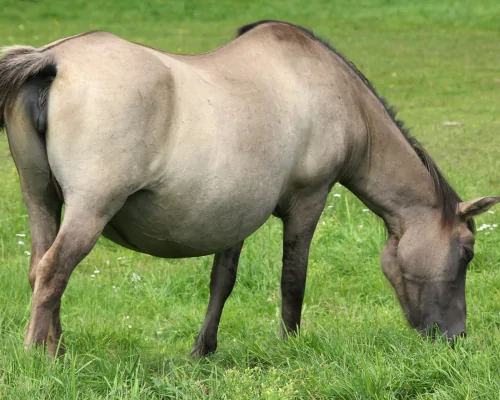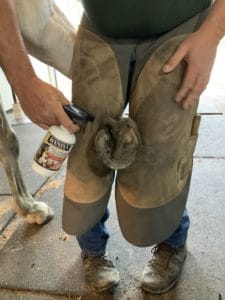When we think of horses, we imagine large and powerful animals that are awe inspiring in their resilience and their endurance.
Heck, we call individuals who are always plowing ahead with their goals “work horses”. It might seem natural to assume horses are a sort of super animal that can always bear more and more weight without issue.
This assumption, however, is wrong. Each horse has their own upper limit to how much weight they should ever be expected to carry and you, as their owner, need to be able to recognize what that level is and when they’ve reached it.
Why Should We Limit How Much Weight Horses Carry?
Like humans, horses (and their bodies) react negatively to being put under too much pressure or weight. Horses who carry more weight than they can comfortably handle can be faced with a number of short- and long-term consequences including rub-sores from the saddle, strained and/or inflamed muscles, pinched nerves, swayback, or even arthritis. A horse tasked with suddenly carrying lots of weight can also quickly begin to feel uncomfortable and forget its training, which can be a potentially dangerous situation for the horse and her rider.
What is Too Much Added Weight?

Child feeding horse
The secondary health effects that too much added weight has on your horse can be significant. Researchers at California State Polytechnic University in Pomona found that horses who trotted on a flat-surfaced treadmill at different speeds – 5.05 miles per hour, 7.4 miles per hour, or 10 miles per hour – with weights on that were equivalent to 19% of their bodyweight displayed an average increase in metabolic rate of 17.6% at all speeds. Over time, this increase in metabolism in response to increased weight burden can lead to a need for increased calories and nutrition.
Those same researchers found that horses bearing a load equivalent to 19% of their bodyweight moved an average of 6% slower than they did without weights added. They also found that the same load weight caused horses to shorten their strides, leave their feet on the ground for longer, and increase their step length with each stride. Horses are forced to make these adjustments to reduce the impact of forces on their individual limbs throughout their gait, which can cause damage in the form of microfractures over time.
Force on Legs
The researchers also noted the magnitude of forces applied to a horse’s individual limbs during the heavy-weight portion of the study were significantly higher than the observed magnitude of forces at the lower weight and no weight portion. This could indicate that, even with proper adjustment, a horse’s body can still be at risk of developing some forms of microdamage from carrying too much added weight. Likewise, a 2008 study completed by Ohio State University’s Agricultural Technical Institute found that horses who carried more than 20% of their body weight displayed noticeably faster breathing and higher heart rates during the study, as well as substantially tighter muscles the day after, than horses who carried lighter loads.
In short, we ought to limit the amount of weight a horse can carry so we can keep them comfortably riding and working for as long as possible.
How Much Weight Can Horses Carry?

Horse wearing saddle
As with most questions regarding the health and safety of our hoofed partners, there is no one-size-fits-all answer to the question of “How much weight can a horse carry?”. In reality, determining the ideal amount of weight for your horse to carry depends on a variety of factors.
That being said, a generally accepted rule of thumb is that a horse’s weight-carrying capacity should never be greater than approximately 20% of their bodyweight. This means that a 1,000 pound horse, for example, should never be expected to bear more than 200 pounds of weight on their back.
What Affects How Much Weight a Horse Can Carry?
There is a combination of many variables that determine how much weight a horse will be able to comfortably carry.
Conformation
Conformation is the horse’s outline as dictated by its bone and muscle structure. More specifically, a horse’s conformation is determined by the length of its bones, the angles of its joints, and the overall proportions and balance of its build. Researchers have found that horses with greater loin width and cannon bone (CB) circumference had a higher weight carrying capacity on average than horses with lower loin widths and CB circumference.

Horse in snow
In their research, they compared the carrying capacity of Icelandic horses and Arabian horses. They found that Icelandic horses, with their compact build and thick cannon bones, were able to work aerobically up until they carried more than 23% of their body weight. As a result of their increased ability to use reserved energy and oxygen, the Icelandic horses displayed lower levels of lactic acid buildup.
This led to less muscle soreness and fatigue than that displayed by the lankier Arabian horses, who could not work aerobically when carrying up to 20% of their body weight. They concluded that horses with short, well-muscled backs and thick cannon bones were more likely to be able to capably carry weight that amounted to more than 20% of their body weight than horses with narrow backs or smaller cannon bones.
Weight Wish-List
Dr. Deb Bennett, an equine anatomist and conformation analyst, has even provided her conformation “wish-list” for weight bearing to Path International. This list attempts to outline what traits a horse should have to comfortably and safely bear additional weight. It reads as follows:
- An excellent loin coupling (the span from the last rib to the hip) – broad, short, smooth, and strong, yet flexible for rounding up the back in order to oppose and neutralize the weight of the rider.
- The circumference about the loin and groin should be about the same as the heart-girth;
- A short to medium-length back;
- A bone-tendon circumference (measured just below the knee) of 8 inches or more per 1000 lbs. of weight. The heavier the horse (or horse + rider + tack) the more bone density the horse needs in order to stay sound;
- A neck set high on the shoulder, with a shallow vertebral curve at the base of the neck;
- Moderately high withers, with a peak that lies well behind the horse’s elbows;
- A pelvis that constitutes at least 30% of the body length and slopes from 18-22 degrees;
- A total body weight of less than 1,450 pounds (658 kg).
General Health and Fitness

Healthy horse leads to healthy weight
Generally speaking, healthier horses are more capable of carrying additional weight than horses who are unhealthy. Unfit or unbalanced horses often lack the strength or agility to adequately lift their back and support additional weight while simultaneously maintaining balance. Horses who are obese (defined as having a body condition score of over 8) may even struggle to carry up to the recommended weight limit of 20% of their body weight. In fact, a study of 366 horses concluded that body condition score was more important in determining whether or not a horse could finish their assigned task than the weight of its rider and tack.
Horses with more developed and muscular toplines are less likely to exhibit signs of muscle soreness or tightness after carrying weight. Using the guidelines prepared by a research team at the Cargill Animal Nutrition Innovation Center, we can define a horse with an ideal topline as displaying a full and rounded athletic appearance without any sunken-in areas. The Horse Feed Blog has more information on how to evaluate your horse’s topline.
Horse Health History
A number of physical ailments and disorders can reduce a horse’s total weight carrying capacity. Horses who have a history of chronic lameness or musculoskeletal issues (especially those involving the back) should never be expected to carry as much weight as a healthy horse. Horses who have been out of work for an extended period of time or who have had insufficient conditioning will have a harder time carrying weight than horses that are continuously active.
Very young and very old horses will also be less able to comfortably carry additional weight than their mature, more athletic counterparts. This makes sense, as young horses’ bones are still developing. On the other hand, older horses have a lifetime of work and play behind them, which can make their bones a bit more fragile or even arthritic, both of which can make them susceptible to damage from added weight. Old horses may also have issues with balancing effectively, so it’s important to go easy on them.
Hoof Health
The health of a horse’s hoof cannot be understated when it comes to determining how much weight they can carry. Without healthy hooves, a horse can’t carry anything – not even itself! Be sure to continually check your horse’s hooves for signs of any injury, infection, or abscesses. If you notice signs of any of the above, schedule a visit with your farrier or equine veterinarian right away.
If you notice evidence of certain fungal or bacterial infection like white line disease in your horse’s hoof, don’t horse around! Act quickly and apply Banixx to the affected area to disinfect it and provide instant no-sting, no-odor relief that’s free from steroids or anti-biotics. Then, remember to follow up with your local farrier to evaluate and treat the underlying cause for infection.
Horses should have their hooves routinely trimmed to ensure that they’re walking on a balanced, flat surface at all times. If your horse seems to constantly wear down their his hooves, consider asking a quality farrier to craft protective shoes or boots.
When looking for a farrier, you want to choose someone who understands the necessity of minimizing unnecessary stress on your horse’s joints and who will keep your horse’s hooves properly trimmed and cared for. The more well-cared-for your horse’s hooves, the better chance they have at being able to safely and comfortably carry additional weight for longer periods of time.
Rider and Horse Experience

Start with light carry weight for your horse
While this may seem less important than, say, rider weight, it’s worth remembering just how heavy and awkward an inexperienced rider can feel to a horse. New riders often don’t know how to carry their own weight and this leaves the horse confused as to how to effectively compensate. As a result of the added work they must do to keep the rider on top, the horse may quickly fatigue and become unable to comfortably continue carrying the added weight.
However, as riders get more experience, they grow to understand how to effectively shift and balance their weight once they’re in motion. Until they learn how to do this, they’re about as graceful and light on a horse’s back as a sack of potatoes.
Likewise, a horse that doesn’t have much experience with riders or extra loads on their back should be given lighter weights to start out with. They need time to develop the muscles on their back that allow them to comfortably carry riders or extra weight.
Type and Intensity of Work

Weight capacity depends on work intensity
The type and intensity level of the work you expect your horse to do both play into how much weight you should expect them to be able to carry. For example, racehorses should only be expected to hold very lightweight saddles and an experienced jockey who moves in motion with the horse in order to reduce drag or feelings of unnecessary weight on their back.
Certain types of workhorses, however, are often perfectly capable of bearing near 20% of their body weight for short periods of time. However, you should aim to keep their loads relatively light if you’re going to work them constantly. Even for the beefiest horses, extended heavy load bearing can still result in negative health consequences down the line.
Additionally, horses that work on rough terrain or are required to complete their work at increased speeds will likely be able to carry less weight. In other words, don’t make a horse’s work harder than it needs to be. That makes sense, right? Would you want to help someone move apartments if they required you wear ankle weights and run the whole time? Probably not!
How Can I Tell My Horse is Carrying Too Much Weight?
Luckily, our horses’ bodies will give us several indicators that they’re probably carrying too much weight for it to be comfortable or safe. For example, horses who are carrying too much weight may have a much faster heart beat after they’ve completed work or a ride.

Happy horse
Horses who are carrying too much weight may also display an unusual degree of muscle soreness, tightness, or stiffness a few hours after they carried the load. Horses who bear heavy weight might begin to breathe very rapidly or sweat more after the fact. In some cases, horses may begin to show signs of fatigue such as lethargy, panting, or loss of muscle coordination. In these instances, the horse may literally become incapable of continuing their task.
If your horse begins displaying any of the above symptoms while working or carrying a rider, immediately unpack some of their load or have the rider dismount and see if their symptoms improve. Added weight is likely the culprit if their symptoms improved. But if their symptoms do not improve, they may be the result of an underlying condition that should be examined by an equine veterinarian.
We know that you just want to keep your horse happy and healthy. We hope you found this article helpful and if your horse ever gets any cuts, abrasions, scratches or white line disease, we hope you keep Banixx Horse & Pet Care in mind.
Sources
- https://nationalridingstables.org/weight-policyhttps://equusmagazine.com/horse-care/weight_carry_062608
- https://www.equisearch.com/articles/too-heavy-for-my-horse
- https://thehorse.com/14024/conformation-in-horses/
- https://beva.onlinelibrary.wiley.com/doi/full/10.1111/eve.13085
- https://www.pathintl.org/path-intl-membership/my-community/63-resources/resources-landing-page/1361-equine-tips-how-much-weight-can-my-horse-carry
- https://www.vettimes.co.uk/app/uploads/wp-post-to-pdf-enhanced-cache/1/weight-limitations-in-horse-riding-how-big-is-too-big.pdf
- https://www.horsefeedblog.com/2016/10/identifying-evaluating-your-horses-topline/
Share this Post
Featured Post
Recent Posts

Managing the Mamas –Part 2 –The development process

Managing the Mamas: Part 1 – Preparing to Breed Your Mare

HOW MANY TOES?? Caring for the Polydactyl Cat

Do Dog Joint Supplements Actually Work?

Are Laser Pointers Bad for Cats? or, are they Purr-e Fun?



